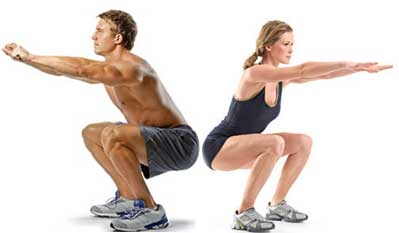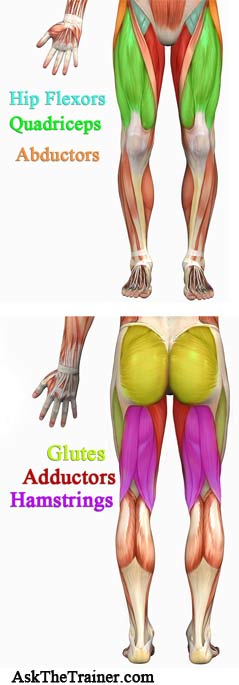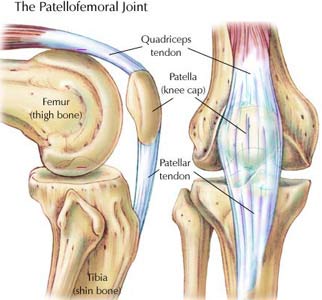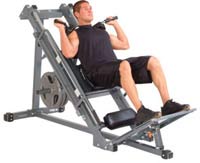- Like
- SHARE
- Digg
- Del
- Tumblr
- VKontakte
- Flattr
- Buffer
- Love This
- Save
- Odnoklassniki
- Meneame
- Blogger
- Amazon
- Yahoo Mail
- Gmail
- AOL
- Newsvine
- HackerNews
- Evernote
- MySpace
- Mail.ru
- Viadeo
- Line
- Comments
- Yummly
- SMS
- Viber
- Telegram
- JOIN
- Skype
- Facebook Messenger
- Kakao
- LiveJournal
- Yammer
- Edgar
- Fintel
- Mix
- Instapaper
- Copy Link
The Best Leg Exercises to Add to Your Routine to Strengthen Your Lower Body

Doing leg exercises is crucial to your success whether you are a bodybuilder, athlete, exercise junkie or someone trying to lose weight.
Resistance training for the legs not only builds and tones the leg muscles, but is responsible for a greater metabolism boost than any other body part.
Here you will find the best leg exercises you can do with free weights in the gym or your own body weight anywhere you please.
Jump to the Videos of the Best Leg Exercises or continue reading to learn more…
A Crash Course in the Basic Leg Anatomy is Necessary to Master the Best Leg Exercises
It is not as simple as just quads and hamstrings. Leg muscle anatomy may seem straightforward when you look at a simple anatomy chart but it’s more complex.
Some muscles or parts of the muscles in the legs are responsible for multiple actions, acting on both the hip and knee joints.

Quadriceps
The quadriceps or “quads” is one of the largest muscle groups in your body. Many of the best leg exercises focus on the quads. The primary function of the quadriceps is leg extension. Leg extension is the motion of extending your knee like kicking a ball.
Hamstrings
The hamstrings flex (curl) your leg. If you lift your heel back toward your butt, your hamstrings perform the action.
Glutes
There are three gluteal muscles. You have likely heard of the gluteus maximus, which is the largest muscle in your body. There is also the gluteus minimus and gluteus medius. The group is often referred to as the glutes.
The primary function of the glutes is to extend your leg at the hip but they have many other functions, such as leg abduction. Abduction is moving your leg away from your body to the side.
Hip Flexors
The hip flexors are the muscles which lift your knee up as if you were about to march. The hip flexors are often tight and overactive in many people, especially those who live a sedentary lifestyle. Tight hip flexors often lead to posture problems.
Adductors
The adductor complex is the group of muscles of your inner thigh. The primary function of the adductors is to adduct your legs, which is the motion of pulling your leg in toward the midline of your body.
Abductors
Abduction is the motion of moving a leg to the side away from your body. Abductors are often referred to as the outer thighs.
You Now Know the Primary Functions of the Major Legs Muscle Groups
Each of the leg muscles has many functions. During every motion, every muscle has to perform different duties. The most simple to understand is the agonist – antagonist relationship.
The agonist is the muscle which performs the primary action and the antagonist is the muscle which opposes it. For example, when you extend your leg, your quadriceps are the agonist. The antagonist muscle on the other side, the hamstrings, lengthen.
This is very important because if the length tension relationship between agonist and antagonist muscles is off, the agonist muscle cannot contract properly. You can learn more about muscle balance and imbalances when you read about posture problems.
The best leg exercises are all functional, multi-joint exercises because they promote muscle balance while working your large muscle groups, which helps with strength gains and weight loss.
The #1 Goal of All Leg Exercises is Essentially the Same for Everybody
It Does Not Matter if You are Young or Old, Male or Female
The common goal of all the best leg exercises is to stay healthy. Whether done through an elliptical trainer or otherwise, leg exercises offer many overall health benefits.
However, all of these benefits will be thrown out the window if you get injured. You have probably experienced some kind of leg or knee pain at one point of your life. Your knees are one of the most vulnerable joints in your body.
To avoid injury, it is very important to know how to perform all of the best leg exercises properly. Let’s take a look at the basic structure of the knee joint so that you will have a better understanding.
To Avoid Knee Injury it is Helpful to Learn the Basic Structure of the Knee Joint
The Knee Actually Consists of 3 different Articulations or Joints
It is important for you to know the difference between the 3 articulations of the knee joint to avoid injury while your perform the best leg exercises. The first joint is the tibiofibular joint. It connects the tibia and fibula, the lower leg bones. It is an arthrodial joint, which means it allows very little motion. You do not have to worry about injuring your tibiofemoral joint
The 2 Joints You Should be Familiar with in the Knee
Tibiofemoral Joint
The tibiofemoral joint is the articulation of the largest bone in your body, the femur (upper leg bone), and the tibia (larger of the 2 lower leg bones.)
The Tibiofemoral Joint is Supported by 4 Ligaments
You may have heard about or even experienced injuries to the knee ligaments, specifically the ACL (Anterior Cruciate Ligament) and MCL (Medial Collateral Ligament.) The tibiofemoral joint is also supported by the 3rd joint involved in the knee: the patellofemoral joint.
ACL and MCL Sprains & Tears are Common Sports injuries
Most of these types of injuries originally occur due to trauma, which is one specific event. The tibiofemoral joint is less likely to have problems related to chronic use during weight training or cardio exercise. The injury may go on to become a chronic problem if it isn’t properly rehabilitated.
Patellofemoral Joint

The patellofemoral joint is the articulation of the patella (kneecap) and the femur.
The Patellofemoral Joint is Prone to Chronic Injuries
Chronic injuries are overuse injuries. Overuse injuries happen over time, and are associated with a specific repetitive motion. This constant overload will eventually cause an injury due to the cumulative injury cycle. Learn all about that here.
Common chronic injuries of the patellofemoral joint are runner’s knee and jumper’s knee. Runners Knee is the common name for chondromalacia patellae, or CMP, which is the degeneration of the back of the kneecap.
Jumper’s knee is patellar tendonitis, which is inflammation of the patellar ligament. Patellofemoral joint problems are frustrating for most active people because they require a long rest period in order to heal.
Overuse injuries can be exacerbated by muscle imbalances, postural problems, and poor exercise form. Be very cautious while you perform the best leg exercises. If you ever experience knee pain, you may need to take a step back. If knee pain persists or is severe, see a doctor right away.
How to Avoid Problems and Injuries with the Knees
Since exercise in the gym often consists of repetitive motions; protecting the patellofemoral joint is a must. This means proper form is necessary at all times when you perform the best leg exercises. The easiest way to minimize stress on the patellofemoral joint is to be aware of the relationship of your knees to your toes during the best leg exercises.
Specifically, your center of gravity should not travel forward while your patellofemoral joint is bearing a load. This simply means keep your hips from traveling forward while your knees are bearing a load. Keep your knee above your foot and ankle complex, never letting it travel beyond the toes.
You can avoid potential patellofemoral problems by using proper form. If you have posture problems which make it difficult or impossible to maintain proper form, you need to visit a physical therapist or personal trainer who can create a customized corrective stretching program to correct muscle imbalances which can cause posture problems.
The Best Leg Exercises
These Leg Exercises are Most Effective Because they are Multi-Joint Functional Movements
The best leg exercises work a large percentage of your lower body muscle mass. The more muscle mass each leg exercise recruits, the more they will positively affect your body composition by encouraging fat loss.
Lunges
Lunges are by far the most effective leg exercise. They dynamically exercise your quadriceps, hamstrings, glutes, as well as your adductors, abductors and calves. We have a whole page devoted to the lunge exercise which includes many lunge variations.
Start: Stand with your shoulders in neutral posture and draw in your core.
Begin the motion: Step forward, gliding your foot along the ground until your heel touches a few feet in front of you. As your front toe lands, bend your front and rear legs until your rear knee is about 1 inch above the floor. Your front heel should be directly below your knee. Both legs should bent at around the same angle which is around 90 degrees.
From the bottom position you have many options. For the basic lunge, you should lift your body up at the same time you bring your hips forward until you are in the original standing position.
Never lunge forward and land on your toes. Never let your front knee wobble side to side and try to avoid all lateral motion in the knees and hips. Always keep your upper body upright; do not lean forward.
Dead Lifts
Start: Take a slightly wider-than-shoulder-width stance. Hinge at the hips as you bend over and grip the barbell with either an overhand or alternating grip. As you set up for the dead lift, you can sit back until your butt is pretty low.
It is crucially important for the entire motion to keep your back flat, and to never let your shoulders fall forward. Do not bend your arms throughout the entire motion.
Stabilize your core and support your lower back as you take a deep breath, which you will hold until the weight is pulled all the way up.
Begin the motion: Keep your core tightly drawn in for the duration of the dead lift. Drive up with your chest. Pull the weight straight up. Make sure to keep it as close to your body as you can. At the top of the motion you must contract your glutes (squeeze your butt) and retract your shoulders. Lower the weight all way back to the floor.
Remember, the dead lift is the act of lifting the weight off the floor. For every repetition, lower the weight all the way to the floor.
The dead lift is an exercise which is best used for low reps. If you perform high reps on the dead lift, there is a good chance your form will break down and you will get injured.
The dead lift is one of the best leg exercises as it is a whole-body task to lift the weight up, but is also a great exercise for your glutes, especially if the bar is low to start.
Hack Squats
 Hack squats are pretty much identical to dead lifts except the bar is held behind your body instead of in the front.
Hack squats are pretty much identical to dead lifts except the bar is held behind your body instead of in the front.
Hack squats are somewhat of a forgotten exercise. You may be familiar with the hack squat machine at your local gym.
This makes hack squats less likely to cause injury than dead lifts. With the bar behind your body, it is less likely your shoulders can fall forward and cause a back injury.
The part about performing hack squats which may be difficult is it may be difficult to get the bar past your butt. Hack squats are far superior to hack squat machines because they are functional and use more muscle mass.
Back Squats
Squats are possibly the most fundamental exercise. They are one of the best leg exercises because they work a good percentage of your muscle mass. Proper back squats will help you get stronger, gain muscle, burn fat and tone your entire body more than any other exercise.
Start: Stand with a barbell on your upper shoulders. There are 2 common positions to put the barbell. The high position is right on top of your Trapezius muscles. The low position is almost in the middle of your Trapezius muscle. The low position is common among power lifters and people lifting very heavy weights. It is recommended you start in the high position.
Begin the motion: The first movement in the back squat is the anterior pelvic rotation. Before you bend your knees, you must rotate your hips forward. This causes your butt to travel backwards. Lower your butt down as if you are sitting on an imaginary chair.
Squat down as far as you can. It is preferable if you squat down until your hips and knees are parallel, but not necessary. After you reach bottom, lead upward with your chest, never letting your shoulders move forward. Contract your glutes as you reach the standing position.
Always keep the core very tightly drawn in during the entire motion of weighted back squats. If performed correctly, weighted back squats are the best choice for many for the best leg exercise.
Another great thing about squats is you can get a good leg workout with just your body weight. There are many variations of squats. You can perform a squat without any weights, or use dumbbells. You can either hold the dumbbells in a high-hang position in front of your shoulders or a low-hang at your sides.
Front Squats
Front squats are the same as back squats except the bar is placed across the anterior deltoids (front of shoulders.)
This requires very strong shoulders if you use a decently heavy weight. If you are able to hold the bar properly front squats are one of the best leg exercises.
Front squats were originally performed as part of the Olympic lift called the clean and jerk. When you perform front squats, you can either hold the bar in high hang position or have your arms crossed in front of you.
An advantage of front squats is that you can usually squat with more range of motion than a back squat.
The major disadvantage is the difficulty of holding the bar, as it is hard on the anterior deltoids and wrists.
Physio Ball Weighted Squats
The physio ball squat is a perfect leg exercise for beginners. It can help teach the proper hip movement for back squats while the legs are in the optimal 90 degree relationship. This will eliminate almost all stress on the lower back.
Start: Place a stability ball against a wall. Lean back into the ball with it positioned in the middle of your back.
Position your feet around shoulder distance apart. You should have your feet about a foot in front of your hips. Hold the dumbbells in a high-hang position at your shoulders or a low-hang position at your sides.
Begin the motion: Draw in your core. Rotate your pelvis anteriorly (stick your butt out) and slowly drop your hips straight down towards the floor. Do not let your hips move forward.
Stop when your hips, knees, and ankles form two 90 degree angles. Pause for a beat before rising back up to the original position.
Step-Ups
Step-ups are one of the best leg exercises because they are truly a functional movement. This means they directly mimic ADLs (activities of daily living) and involve stabilization in different planes.
Start: You can use pretty much anything to step up on, just make sure it is stable, especially if you use weight.
Begin the motion: Draw in your core. Step up to the box. Make sure when you land, you land on your heel and not your toes. Squat yourself up with the leg you stepped up with, contracting your glutes at the top.
You may or may not use weight in the form of a dumbbell or barbell. You can add different upper body exercises with step-ups. Just make sure you have mastered balancing during the step-up before you try to progress the difficulty of this best legs exercise.
Romanian Dead Lifts
The RDL or Romanian Dead Lift is one of the best legs and butt exercises. Out of all the best leg exercises it is the best hamstring exercise because it is a functional, mutli-joint movement. Many women claim that the RDL really helps reduce cellulite and tighten up the backside.
The RDL is an advanced movement which takes proper instruction and practice to master.
Start: You can either have a loaded barbell or dumbbells on the floor or in a low hang position. Keep your legs in a slightly bent position for the duration of the movement. Keep your shoulders stabilized in a retracted position for the duration of the movement.
Begin the motion: It is essential to have a super-tight, drawn-in core as you begin this motion. Never, ever let your back round. Stick your butt backwards lowering the bar or dumbbells as close to your body as possible. Only lower the bar to where you can maintain strict form. Raise the weight back up by straightening your legs. At the top of the motion it is very important you retract your shoulder blades (squeeze them together) and contract your glutes.
You Have Already Learned the Best Leg Exercises, but There are Many More Great Leg Exercises to Learn
As you have discovered in this article, the best leg exercises are all functional exercises which involve multiple muscle groups and stabilization in multiple planes of motion. The best leg exercises work the large muscle groups of the legs and their supporting muscles, instead of isolating individual muscles. Isolating the supporting muscles may cause muscle imbalances, which often leads to injury.
Essential Reading to Help You Get the Most out of the Best Leg Exercises
- Sets and Reps for Leg Workouts
You know the best leg exercises, but how many repetitions should your perform? How many sets? Learn how to determine how many sets and reps you should perform for every exercise, including the best leg exercises - Best Lower Body Workout for Women
Do you want to attempt to build the muscles which are the most desirable for most women? If you are looking to add inches to your glutes, tone them, or be able to jump out of the gym, the best lower body exercises will help you reach your goals.
About Michael Behnken
Mike Behnken is a personal trainer who holds multiple NASM certifications and a MS in Exercise Science. Mike loves fitness, travel, and photography among many other interests.

